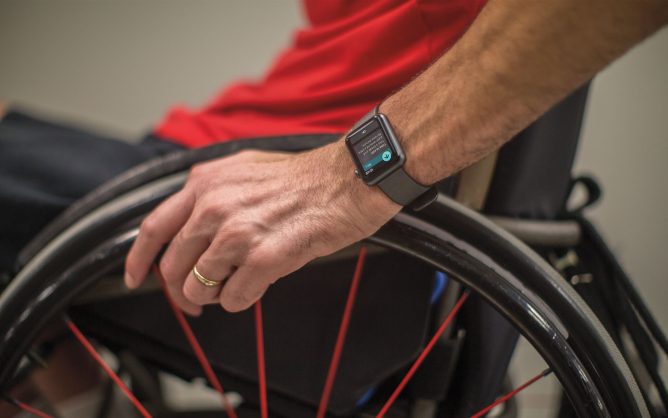Fitness trackers and smart watches have routinely measured physical activity such as running and cycling and encouraged people to stand up and walk about throughout the day. However, if you’re in a wheelchair, you’re out of luck.
As part of the upcoming Apple iWatch 3.0 software update, iWatch wheelchair users will be able to keep track of distance, calories burned and heart rate during wheelchair use, just as it does for walking or running.
Jeff Williams, Apple’s chief operating officer, said the feature isn’t about market opportunities.
“We want to make products that serve every walk of life,” Williams said in an interview. “We realize that while it was great for messages on the wrist, we wanted to offer this group of people the same opportunity to get healthier using Apple Watch.”
Apple partnered with two groups that promote physical fitness in disability populations, the Lakeshore Foundation of Birmingham, Alabama, and the Challenged Athletes Foundation of San Diego. The two groups recruited about 300 people in wheelchairs for more than 3,000 hours of activity research.
Jeff Underwood, Lakeshore’s president and CEO, said wheelchair users tend to be more sedentary than the general population because they face more barriers to physical activity. Although having a fitness device alone won’t make someone fit, he said, having one sends a message that inactivity shouldn’t be the norm.
The feature is part of a free software update, watchOS 3.0, expected later this year. No new hardware is required.
“The $300-and-up Apple Watch appears to be the first fitness device to offer extensive wheelchair capabilities. GPS wristwatches can measure distance and speed fairly accurately, but calorie measurements assume moving the entire body”, said Dawna Callahan, a four-time wheelchair finisher in the Boston Marathon and director of programs at Challenged Athletes. “In addition, GPS devices aren’t good for all-day tracking because of battery constraints.”
Apple largely had to start from scratch because past scientific studies on burning calories weren’t designed with wheelchair subjects. The company couldn’t simply translate formulas meant for walking and running.
For one thing, people push their wheelchairs differently when approaching a ramp or circumventing an obstacle. Apple also had to factor in different seat and wheel heights and different surfaces, like carpeting or asphalt. And some formulas change depending on whether the disability is from a spinal-cord injury or muscular dystrophy.
“The more you look into it, the harder and more challenging you realize it was,” said Ron Huang, Apple’s director of software engineering for location and motion technologies.
The Apple Watch already has larger watch faces for the sight-impaired and a mono audio mode for those with hearing difficulties in one ear. The upcoming watchOS 3.0 update will also have an option for “displaying” the time using Morse code and other tactile feedback.

